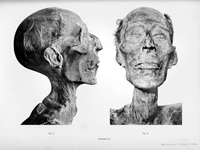A planet may have been destroyed by a white dwarf at the center of a planetary nebula - the first time this has ever been seen. This destruction could explain the mysterious X-ray signal astronomers have been detecting from the Helix Nebula for more than 40 years.
Helix is a planetary nebula, a late-stage star that, like our Sun, has shed its outer layers, leaving at its center a small faint star called a white dwarf.
The first image in this post is a composite image of the Helix Nebula with X-rays from Chandra (magenta), optical light data from Hubble (orange, light blue), infrared data from ESO (gold, dark blue) and ultraviolet data from GALEX (purple). Data from Chandra show that this white dwarf destroyed a planet orbiting very close to it.
The second image in this post is an artist's rendering showing a planet (left) coming very close to a white dwarf (right) and being torn apart by tidal forces from the star. The white dwarf is in the center of a planetary nebula, depicted by the blue gas in the background. The planet is part of a planetary system that includes a planet in the upper left and another planet in the lower right. The beleaguered planet may have initially been quite far away from the white dwarf, but then migrated inward, interacting with the gravity of other planets in the system.
Eventually, debris from the planet would form a disk around the white dwarf and fall to the surface of the star, creating the mysterious signal in X-rays that astronomers have detected for decades.
X-ray missions such as the Einstein Observatory and the ROSAT telescope have taken an unusual reading from the center of the Helix Nebula since 1980. They detected high-energy X-rays coming from the white dwarf at the center of the Helix Nebula called WD 2226-210, located just 650 light-years from Earth. White dwarfs like WD 2226-210 do not typically emit strong X-rays.
A new study involving Chandra and XMM-Newton data may have finally solved the question of what is causing these X-rays from WD 2226-210: this X-ray signal could be the debris of a destroyed planet that was pulled onto the white dwarf. If confirmed, this would be the first case of a planet being destroyed by the central star in a planetary nebula.
Observations by ROSAT, Chandra and XMM-Newton between 1992 and 2002 show that the X-ray signal from the white dwarf remained approximately constant in brightness during this time. However, the data suggest that there may be a subtle and regular change in the X-ray signal every 2.9 hours, providing evidence for the remains of a planet extremely close to the white dwarf.
Previously, scientists had found that a planet the size of Neptune was in a very close orbit around the white dwarf, completing one revolution in less than three days. In this latest study, the researchers concluded that a planet like Jupiter could be even closer to the star. The beleaguered planet may have initially been quite far from the white dwarf, but then migrated inward, interacting with the gravity of other planets in the system. When it got close enough to the white dwarf, the star's gravity may have partially or completely torn the planet apart.
WD 2226-210 has some similarities in X-ray behavior to two other white dwarfs that are not in planetary nebulae. One is probably pulling matter from a planetary companion, but more quietly, before the planet is rapidly destroyed. The other white dwarf is probably pulling material to its surface from the remains of a planet. These three white dwarfs could form a new class of variable or changing objects.
Visual Explanations:
Image 1:
The Spiral Nebula is a cloud of gas ejected by a dying star known as a white dwarf. In this composite image, the gas cloud resembles the eye of a creature. Here, a hazy blue cloud is surrounded by hazy, concentric rings of pale yellow, rose pink and blood orange. Each ring appears to be dusted with gold particles, especially the outer edges of the eye shape.
The entire image is speckled with glowing dots in blue, white, yellow and purple. In the center of the hazy blue gas cloud, a box labeled WD 2226-210 is drawn around a bright white dot with a pink outer ring and a smaller white dot.
Image 2:
This artist's concept shows a possible cause of the large white dot with the pink outer ring. A bright white circle near our upper right shows a white dwarf, the grove of a dying star. To our lower left, in the relative foreground of the image, are the remains of a planet. Here, the planet resembles a giant boulder from which thousands of small rocks have fallen. These rocks are flowing off the planet's surface and retreating in a long, sinuous tail toward the white dwarf. Glowing orange fault lines cover the surface of the crumbling planet. To our upper left and lower right, in the hazy blue clouds obscuring the image, are two more distant planets. X-rays should be produced after rocks from the planet begin to hit the surface of the white dwarf.
Image 3:
This image is identical to the first image in this article, without the pictured box surrounding the central features of the nebula.
X-ray (Chandra): NASA/CXC/SAO/Univ Mexico/S. Estrada-Dorado et al;
Ultraviolet (GALEX): NASA/JPL;
Optical (Hubble): NASA/ESA/STScI (M. Meixner)/NRAO (T.A. Rector);
Infrared (ESO): ESO/VISTA/J. Emerson;
Image Processing: NASA/CXC/SAO/K. Arcand;
Illustration: NASA/CXC/SAO/M. Weiss


 Nielawore
Nielawore











Yorum yazmak için lütfen giriş yapınız